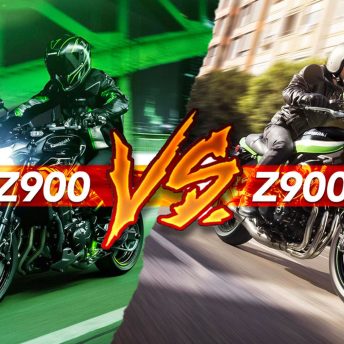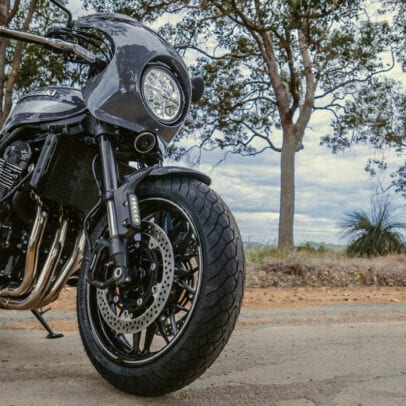2022 is the 50th anniversary of Kawasaki’s Z series of motorcycles. To help mark the occasion we’re looking at the development of the Z900RS, a retro-modern motorcycle that Kawasaki designed as a homage to the original Z1.
The Kawasaki Z1 is to motorcyclists what the Stratocaster is to musicians, the Ford Mustang is to car nuts or Megan Fox is to teenage boys. It’s an icon. So when Kawasaki decided to bestow the moniker on a new model it was a VERY BIG THING. And they were determined to make a project of it. They weren’t going to yank the panels off an old design, throw some new paint at it and shuffle off to sleep on a pile of money (they’re not Harley Davidson).
If the Z900RS was to be a true landmark release the project had to be a truly special bike. It would have to be worthy of the Z moniker, and not a cheap cash-in of the halcyon days of motorcycling. Enter the elusive motorcycle designer Norikazu Matsumura (pictured right below).
Matsumura-san and Kawasaki already had a history. He’d been used to head the design team that revised the W650 into the W800 — hiding a fuel injection system so neatly into a naked it would have to bend over and cough to be seen. And the keen-eyed designer was already a card-carrying, mask-wearing, hymn-chanting member of the Z1 cult. He’s got one of its descendants at home, the Zephyr 750, that he rides, fixes, modifies and stares at in his spare time. So what better person to head the styling team of the Z900RS?
Matsumura-san started with the tank. And while the teardrop design of the original is one of its most striking features, it’s also the hardest to replicate with modern technology.
Modern fuel injection systems require an array of sensors, pumps, wiring and vacuums that sit within the fuel tank for protection and cooling. You couldn’t just stick a fuel pump system in the old model tank and hope to retain any kind of fuel capacity.
So instead the new tank actually sits down behind the side covers. This gives it the look of being svelte, while actually having a bit of meat to it. It’s the shaping underwear of the bike world. All that cleverness gives the Z900RS a fuel capacity of 17 litres. Only one less than the standard Kawasaki Z900.
At the rear end, a redesigned subframe allowed the iconic ducktail seat to be mounted. Bam, you’ve got a bike that looks a little like a Z1. And Norikazu could have ended it there. But the homages to 1972’s groundbreaking bike are quite a bit deeper than you’d think. And this is where Norikazu Matsumura’s eye for detail came into play.
Take the twin dials of the Kawasaki Z900RS. Sure, it’s a twin mount with a similar size and shape to the originals. But the typeface is actually the same as the 1972 model and the needles were modelled after the original. It’s a tiny detail that Kawasaki didn’t have to do. But they wanted to.
That continues with the finish. Not only does it have the difficult-to-replicate-without-getting-cancer ‘root beer’ scheme from the 70s, but it also features side cover badges that have a stippled effect under the ‘Z900RS’ text. That’s damn hard to make. And it’s the kind of thing you’d only notice if you were an obsessive rivet counter.
But that’s not all. The LED taillight has the bulbs arranged in such a way it looks like the flare of an analogue globe inside. The headlight is a damn-near copy of the 1972 model. And its running light mode lights up the entire unit, just like an old Japanese bike.
But there are omissions. Things that people complain about. And they’re all wrong.
Firstly, the wheels.
In darkened corners at Kawasaki HQ, arguments went back and forwards about the use of spokes. And while it would have been ideal to run a set of heavy, expensive and difficult-to-maintain spokes, team green opted to run modern alloy wheels. Because, well, they’re not heavy, expensive and difficult to maintain. But the spoke pattern is reminiscent of a set of wires, and they’re finished with polished edges much like a set of 70s or 80s alloys. Because ultimately Kawasaki wanted the Z to handle like a new ride.


This is why you’ll find the Z900RS runs a 4-1 exhaust. While the twin mufflers of the original are certainly a cornerstone of the design, excess weight isn’t. And the gorgeous standard stainless system is damn near a feature in itself.
Lastly, the bike is mono-shock. No matter what the dribbling old bloke down the pub says about what makes a ‘real’ retro bike, Kawasaki decided to cut no corners when it came to handling. Twin shock mounts are a heavy, imprecise and inefficient way of controlling the back end of a motorcycle.
Rather than a Triumph-like carbon copy or a hard overdose on nostalgia like Harley Davidson, the Kawasaki Z900RS is a bike that nods quietly to its history. It features all the touchstones of what made the original bike so gorgeous, but it hasn’t sacrificed a single thing to get there.
Story by Marlon Slack | Photography via Kawasaki Motors












